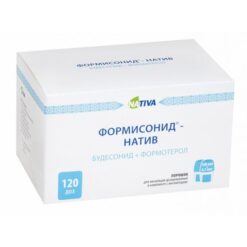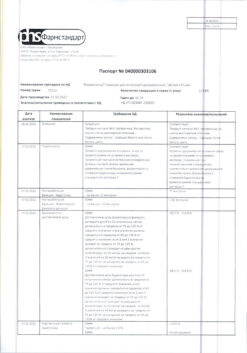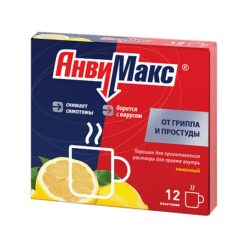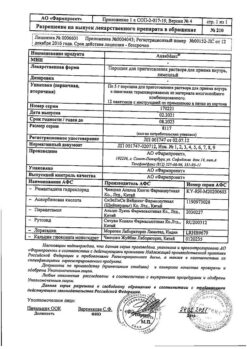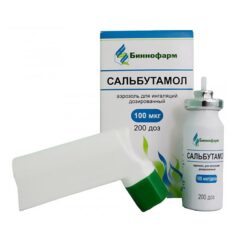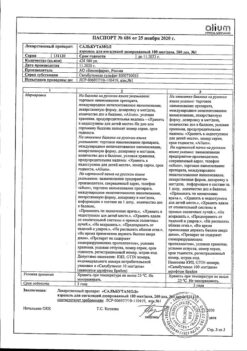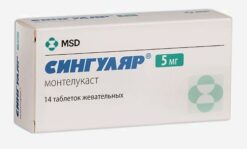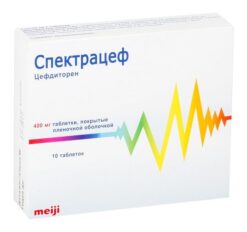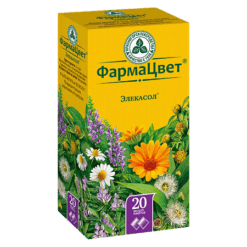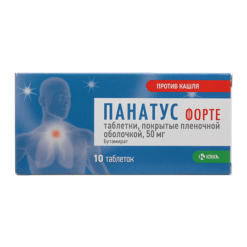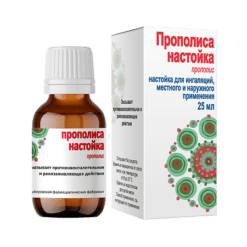No products in the cart.
Formisonide-Nativ 160 mcg + 4.5 mcg/dose, 60 pcs.
€1.00
Out of stock
(E-mail when Stock is available)
Description
Formisonide®-antibody is a combination medication containing formoterol and budesonide which have different mechanisms of action and show additive effects with respect to the severity of bronchial asthma (BA) symptoms, improvement of lung function and reduction of the frequency of exacerbations of bronchial asthma and chronic obstructive pulmonary disease (COPD).
The special properties of budesonide and formoterol make it possible to use their combination in the treatment of bronchial asthma simultaneously as maintenance therapy and for the relief of attacks, or as maintenance therapy.
Budesonide is a glucocorticosteroid (GCS) that has a rapid (within hours) and dose-dependent anti-inflammatory effect on the airway, reducing the severity of symptoms and the frequency of exacerbations of bronchial asthma after inhalation in the recommended doses. When prescribing inhaled budesonide, there is a lower incidence of serious adverse effects than when using systemic GCS. Budesonide reduces the severity of bronchial mucosal edema, mucus production, sputum formation and airway hyperresponsiveness. The exact mechanism of anti-inflammatory action of GCS is unknown.
Formoterol is a selective β2-adrenomimetic (selective β2-adrenoreceptor agonist) that causes rapid and prolonged relaxation of bronchial smooth muscle in patients with reversible airway obstruction.
The bronchodilator effect is dose-dependent, occurs within 1-3 minutes after inhalation and persists for at least 12 hours after a single dose.
The effect of Formisonide®-antibody on lung function is similar to that of the combination of budesonide and formoterol monotherapy and greater than that of budesonide alone.
Indications
Indications
– Bronchial asthma, as maintenance therapy and for the relief of attacks (insufficiently controlled by the use of inhaled GCS and short-acting β2-adrenergic agonists as on-demand therapy, or adequately controlled by inhaled GCS and long-acting β2-adrenergic agonists);
– chronic obstructive pulmonary disease (symptomatic therapy in patients with severe COPD with FEV1 <50% of the estimated calculated level and with a history of repeated exacerbations, in the presence of severe symptoms of the disease, despite therapy with long-acting bronchodilators).
Pharmacological effect
Pharmacological effect
Formisonide®-native is a combination drug containing formoterol and budesonide, which have different mechanisms of action and exhibit an additive effect on the severity of symptoms of bronchial asthma (BA), improving lung function and reducing the frequency of exacerbations of bronchial asthma and chronic obstructive pulmonary disease (COPD).
The special properties of budesonide and formoterol make it possible to use their combination in the treatment of bronchial asthma simultaneously as maintenance therapy and to relieve attacks, or as maintenance therapy.
Budesonide, a glucocorticosteroid (GCS), after inhalation in recommended doses, has a rapid (within several hours) and dose-dependent anti-inflammatory effect on the respiratory tract, reducing the severity of symptoms and the frequency of exacerbations of bronchial asthma. When prescribing inhaled budesonide, there is a lower incidence of serious adverse effects than when using systemic corticosteroids. Budesonide reduces the severity of edema of the bronchial mucosa, mucus production, sputum formation and airway hyperresponsiveness. The exact mechanism of the anti-inflammatory effect of GCS is unknown.
Formoterol is a selective β2-adrenergic agonist (selective β2-adrenergic receptor agonist) that causes rapid and prolonged relaxation of bronchial smooth muscles in patients with reversible airway obstruction.
The bronchodilator effect is dose-dependent, occurs within 1-3 minutes after inhalation and persists for at least 12 hours after taking a single dose.
The effect of the drug Formisonide®-native on lung function corresponds to the effect of the combination of budesonide and formoterol monotherapy and exceeds the effect of budesonide alone.
Special instructions
Special instructions
It is recommended to gradually reduce the dose of the drug before stopping treatment and it is not recommended to abruptly discontinue treatment.
Dosages 80 + 4.5 mcg/dose and 320 + 9 mcg/dose are not intended for the treatment of patients with severe asthma.
Formisonide®-native is not intended for the initial selection of therapy in the first stages of treatment of bronchial asthma and COPD.
If therapy is insufficiently effective or the maximum recommended doses of Formisonide®-native are exceeded, it is necessary to reconsider treatment tactics.
An increase in the frequency of taking bronchodilators as emergency medications indicates a worsening of the course of the underlying disease and is the basis for revising the treatment tactics for bronchial asthma.
Sudden and progressive deterioration in control of symptoms of asthma or COPD is a potentially life-threatening condition and requires urgent medical attention. In this situation, the possibility of increasing the dose of GCS should be considered, i.e. prescribing a course of oral GCS or antibiotic treatment in case of infection.
Patients should always have emergency medications with them: Formisonide®-native (for patients with bronchial asthma using Formisonide®-native for maintenance therapy and to relieve attacks) or short-acting β2-agonists (for patients using Formisonide®-native only for maintenance therapy).
The patient should be explained the need to regularly take a maintenance dose of Formisonide-native in accordance with the selected therapy, even in cases where there are no symptoms of the disease.
Inhalations of the drug Formisonide®-native (80 + 4.5 mcg/dose and 160 + 4.5 mcg/dose) to relieve attacks should be carried out only when symptoms occur, but the use of the drug is not indicated for regular preventive use, i.e. before physical activity. In such cases, the use of a separate short-acting β2-agonist is indicated.
If the symptoms of bronchial asthma are controllable, the dose of Formisonide®-native can be gradually reduced, and it is important to constantly monitor the patient’s condition. The lowest effective dose should be prescribed (see section “Dosage and Administration”).
Treatment with Formisonide-native should not be started during an exacerbation of bronchial asthma.
As with any other inhaled drug, paradoxical bronchospasm may occur with an immediate increase in wheezing after taking a dose of Formisonide®-native. In this case, you should stop therapy with Formisonide-native, reconsider treatment tactics and, if necessary, prescribe alternative therapy.
When taking any inhaled corticosteroids, especially when taking high doses of drugs over a long period of time, systemic effects may occur. Systemic effects are less likely to occur with inhalation therapy than with oral corticosteroids. Possible systemic effects include adrenal suppression, decreased bone mineral density, cataracts, and glaucoma.
Due to the potential effect of inhaled corticosteroids on bone mineral density, special attention should be paid to patients taking the drug in high doses for a long time with risk factors for osteoporosis. Studies of long-term use of inhaled budesonide in adults at a daily dose of 800 micrograms (metered dose) showed no significant effect on bone mineral density. There is no data regarding the effect of high doses of the drug on bone mineral density.
If there is reason to believe that adrenal function has been impaired due to previous systemic GCS therapy, precautions should be taken when transferring patients to Formisonide®-native.
Inhaled budesonide therapy generally minimizes the need for oral corticosteroids, but patients who discontinue oral corticosteroids may experience long-term adrenal insufficiency. Patients who in the past required acute use of high doses of corticosteroids or received long-term treatment with high-dose inhaled corticosteroids may also be at this risk. One should be aware of the possibility of residual adrenal dysfunction in such patients in extreme cases and in any situations that may cause stress (including surgical interventions). In such situations, it is necessary to provide adequate treatment for GCS. Depending on the degree of adrenal dysfunction, it may be necessary to consult a specialist before undergoing recommended procedures.
It is possible to develop a candidal infection of the oral cavity. To reduce the risk, patients are advised to rinse their mouth thoroughly with water after each inhalation of the drug. If a candidiasis infection of the oral cavity develops, it is possible to carry out local antifungal therapy without stopping treatment with Formisonide®-native.
Special precautions should be taken in patients with unstable bronchial asthma using short-acting β2-adrenergic agonists to relieve attacks during exacerbation of severe bronchial asthma, because the risk of developing hypokalemia increases against the background of hypoxia and in other conditions when the likelihood of developing symptoms of hypokalemic action increases. In such cases, it is recommended to monitor serum potassium levels.
During treatment, blood glucose concentrations should be monitored in patients with diabetes mellitus.
The use of formoterol in a dose exceeding 54 mcg/day (more than 12 inhalations of Formisonide®-native in doses of 80 + 4.5 mcg or 160 + 4.5 mcg or more than 6 inhalations in a dose of 320 + 9 mcg) may lead to positive doping test results.
Features of the effect of the drug upon its withdrawal
Due to the risk of exacerbation, sudden discontinuation of the drug Formisonide-native should be avoided; the dose of the drug should be reduced gradually under the supervision of a physician.
Active ingredient
Active ingredient
Budesonide, Formoterol
Composition
Composition
For one capsule:
Active substance: 80 mcg + 4.5 mcg 160 mcg + 4.5 mcg 320 mcg + 9 mcg
Budesonide 80 mcg 160 mcg 320 mcg
Formoterol fumarate dihydrate 4.5 mcg 4.5 mcg 9 mcg
Excipients:
sodium benzoate,
lactose monohydrate
Contraindications
Contraindications
Children under 6 years of age (for dosages of 80 mcg + 4.5 mcg and 160 mcg + 4.5 mcg)
Children under 12 years of age (for dosage 320 mcg + 9 mcg)
Breastfeeding.
Hypersensitivity and/or intolerance to any of the components of the drug.
Rare hereditary diseases such as lactose intolerance, lactase deficiency or glucose-galactose malabsorption.
If you have one of the listed diseases, be sure to consult your doctor before using the drug. Particular caution when using the drug Formoterol-native (especially in terms of dose reduction) and careful monitoring of patients is required in the presence of the following concomitant diseases: IHD; disturbances of heart rhythm and conduction, especially AV blockade of the third degree; severe heart failure; idiomatic hypertrophic subaortic stenosis; severe arterial hypertension; aneurysm of any location; pheochromocytoma; ketoacidosis; hypertrophic obstructive cardiomyopathy; thyrotoxicosis; known or suspected prolongation of the QTc interval (QT corrected >0.44 sec). Considering the hyperglycemic effect characteristic of beta2-adrenergic agonists, additional regular monitoring of blood glucose concentrations is recommended in patients with diabetes mellitus taking Formoterol-native.
Side Effects
Side Effects
No increase in the incidence of adverse reactions was observed during the co-administration of budesonide and formoterol.
Adverse reactions are distributed according to frequency of occurrence. The following criteria were used to assess the frequency: very often (>1/10), often (from 1/100 to 1/10), infrequently (from 1/1000 to 1/100), rarely (from 1/10000 to 1/1000), very rarely (<1/10000), (including individual reports).
Infectious and parasitic diseases: often – nasopharyngitis, nasal congestion, sinusitis, upper respiratory tract infections, bronchitis, oropharyngeal candidiasis (candidiasis of the oral mucosa and larynx).
Immune system disorders: rarely – anaphylactic reactions, including angioedema (Quincke’s edema); bronchospasm, including paradoxical.
Endocrine system disorders: rarely – hypokalemia; very rarely – hyperglycemia, symptoms of systemic glucocorticosteroid effects (including hypocortisolism, hypercortisolism.
Mental disorders: infrequently – psychomotor agitation, restlessness, anxiety, dizziness, sleep disturbances; very rarely – depression, behavioral disorders, aggressive behavior, nervousness, taste disturbances.
Disorders of the central nervous system: often – headache.
Visual disturbances: very rarely – cataracts, glaucoma (with long-term use of high doses), increased intraocular pressure.
Cardiac disorders: often – palpitations; infrequently – tachycardia; rarely – arrhythmias, including atrial fibrillation, supraventricular tachycardia, extrasystole; very rarely – angina pectoris, atrial and ventricular tachyarrhythmia.
Vascular disorders: very rarely – changes in blood pressure (hypotension, arterial hypertension).
Disorders of the respiratory system, chest and mediastinal organs: often – irritation in the throat, cough, hoarseness; rarely – dysphonia (disappearing after stopping therapy or reducing the dose of the drug).
Gastrointestinal disorders: often – discomfort in the stomach, rarely – vomiting, very rarely – nausea, dysphagia (impaired swallowing).
Disorders of the skin and subcutaneous tissues: infrequently – bruising, rarely – urticaria, itching, dermatitis, rash, very rarely – redness of the facial skin.
Musculoskeletal and connective tissue disorders: often – tremor, infrequently – muscle cramps; rarely – osteoporosis (decreased bone mineral density), back pain.
The systemic effect of inhaled corticosteroids can be observed when taking the drug in high doses for a long time.
The use of β2-adrenergic agonists can lead to an increase in the blood levels of insulin, free fatty acids, glycerol, and ketone derivatives.
If any of the side effects indicated in the instructions get worse or you notice any other manifestations not listed in the instructions, tell your doctor.
Interaction
Interaction
With simultaneous oral administration of ketoconazole at a dose of 200 mg 1 time per day and budesonide at a dose of 3 mg, the concentration of budesonide in plasma increases on average 6 times. When taking ketoconazole 12 hours after taking budesonide, the concentration of the latter in plasma increases on average 3 times. There is no information about such an interaction with budesonide when administered inhaled, but a noticeable increase in the concentration of budesonide in the blood plasma should be expected.
It is not recommended to prescribe Formisonide-native as maintenance therapy and for the relief of attacks in patients receiving potent CYP3A4 inhibitors since there are no data for dose selection recommendations; the above-described combination of drugs should be avoided. If it is impossible to avoid the use of a combination of these drugs, then the intervals between their doses should be increased as much as possible. A dose reduction of budesonide should also be considered.
Formisonide native should not be co-administered with β-blockers (including eye drops), as they may weaken or inhibit the effect of formoterol, except in cases of emergency.
With simultaneous use of the drug Formisonide®-native and quinidine, disopyramide, procainamide, phenothiazines, antihistamines (terfenadine), monoamine oxidase inhibitors (MAO) and tricyclic antidepressants, the QTC interval may be prolonged and the risk of ventricular arrhythmias may increase.
Levodopa, levothyroxine sodium, oxytocin and ethanol can reduce the tolerance of the heart muscle to β2-agonists.
With the simultaneous administration of the drug Formisonide®-native monoamine oxidase inhibitors (MAOIs), as well as drugs with similar properties, an increase in blood pressure is possible.
When performing anesthesia with halogenated hydrocarbon drugs while using the drug Formisonide®-native, there is an increased risk of developing arrhythmias in patients.
When taking Formisonide®-native and other β-adrenergic agonists simultaneously, the side effects of formoterol may increase.
The hypokalemic effect of β2-adrenergic agonists can be enhanced by the simultaneous administration of xanthine derivatives, mineral derivatives of corticosteroids and diuretics. Hypokalemia increases the susceptibility to the development of arrhythmias in patients taking cardiac glycosides.
Methandienone and estrogens enhance the effect of budesonide.
There is no interaction of budesonide with other drugs used to treat bronchial asthma.
Overdose
Overdose
Symptoms: in case of acute overdose of budesonide, which is part of the drug Formisonide®-native, no clinically significant symptoms are expected. With chronic use of budesonide in excessive doses, the systemic effect of GCS may occur.
In case of an overdose of formoterol, tremor, nervousness, insomnia, headache, dizziness, palpitations, tachycardia, angina pectoris, changes in blood pressure, metabolic acidosis, and in some cases hyperglycemia, hypokalemia, prolongation of the QTC interval, arrhythmias, nausea, increased nervous excitability, muscle spasms may be observed.
Treatment: supportive and symptomatic treatment is indicated.
Manufacturer
Manufacturer
Nativa, Russia
Additional information
| Manufacturer | Nativa, Russia |
|---|---|
| Medication form | Powder for preparation of solution for inhalation |
| Brand | Nativa |
Other forms…
Related products
Buy Formisonide-Nativ 160 mcg + 4.5 mcg/dose, 60 pcs. with delivery to USA, UK, Europe and over 120 other countries.


